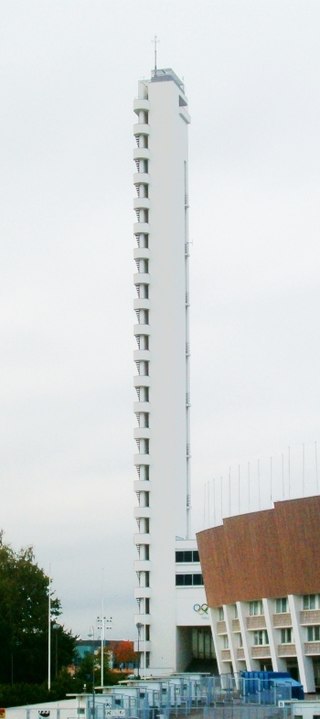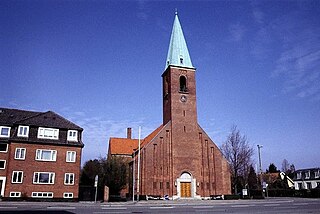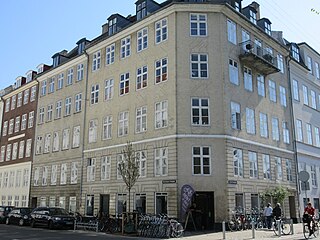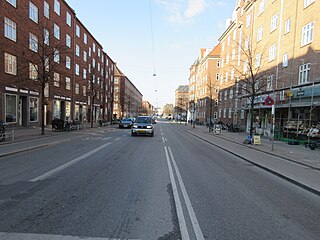
Copenhagen Airport, Kastrup is an international airport serving Copenhagen, the capital of Denmark, as well as Zealand, the Øresund Region, and southern Sweden including Scania. In 2023 it is the largest airport in the Nordic countries.

In architecture, functionalism is the principle that buildings should be designed based solely on their purpose and function. An international functionalist architecture movement emerged in the wake of World War I, as part of the wave of Modernism. Its ideas were largely inspired by a desire to build a new and better world for the people, as broadly and strongly expressed by the social and political movements of Europe after the extremely devastating world war. In this respect, functionalist architecture is often linked with the ideas of socialism and modern humanism.

Slagelse is a town on Zealand, Denmark. The town is the seat of Slagelse Municipality, and is the biggest town of the municipality. It is located 15 km east of Korsør, 16 km north-east of Skælskør, 33 km south-east of Kalundborg and 14 km west of Sorø.
Vilhelm Lauritzen was a leading Danish modern architect, founder of the still active architectural firm Vilhelm Lauritzen Arkitekter.

Fiolstræde is a pedestrianised shopping street in central Copenhagen, Denmark. It passes the square Frue Plads on its way from Nørreport station in the north to Skindergade in the south where Jorcks Passage connects it to the shopping street Strøget. Copenhagen Cathedral is located on the street which also passes the rear side of Copenhagen University Library.

The Danish Embassy in Washington, D.C. is the Kingdom of Denmark's diplomatic mission to the United States. It is located at 3200 Whitehaven St., NW in Washington, D.C. The embassy also operates consulates-general in Chicago, Houston, New York City and in Palo Alto, California.

Savoy Hotel Copenhagen is a 66-room, privately run hotel located at Vesterbrogade 34 in the Vesterbro district of Copenhagen, Denmark. The hotel is based in the rear wing of the Løvenborg Building, Denmark's first example of Art Nouveau.
Vilhelm Lauritzen Architects (VLA) is an architectural firm based in Copenhagen, Denmark. It was founded by Vilhelm Lauritzen, who headed the firm from its foundation in 1922 until 1969.

Radiohuset is the former headquarters of national Danish broadcaster DR, located on Rosenørns Allé in Frederiksberg, Copenhagen. The building complex was inaugurated in 1945 to a Functionalist design by Vilhelm Lauritzen and later expanded in 1958 and 1972. Vacated by DR when DR Byen was inaugurated in 2006, the buildings now house the Royal Danish Academy of Music as well as the Museum of Music. The complex also contains a concert hall. The building was listed in 1994.

TV-Byen is the former headquarters of national Danish broadcaster DR, located in Gladsaxe, approximately 9 kilometres northwest of central Copenhagen, Denmark. The 207,000 m2 site has been redeveloped with a mixture of offices, housing and retail after DR inaugurated their new headquarters, DR Byen in 2007.

Bernstorffsvej is a major road in the Gentofte Municipality, located in the northern suburbs of Copenhagen, Denmark. It runs from Lyngby to a five-way roundabout on Jægersborg Allé in the north. The road passes several notable Danish buildings, including Gentofte Town Hall, Helleruplund Church, the Roman Catholic, St. Theresa's Church, Hellerup Cemetery and Bernstorff Park.

Palægaragerne is an early Modernist parking facility and filling station located in a narrow courtyard at Dronningens Tværgade 4 in central Copenhagen, Denmark. It was built in the early 1930s and was the first multi-storey parking facility in Denmark. It takes its name after the neighboring Moltke Mansion. The parking facility and the canopy over the filling station were listed on the Danish registry of protected buildings and places by the Danish Heritage Agency on 13 July 1994. It is now owned by the property company Jeudan.

The Langelinie Pavilion is a venue located at the Langelinie waterfront in Copenhagen, Denmark. The first Langelinie Pavilion was built in the 1880s but the current building is a Modernist structure from 1958 and was designed by Nils and Eva Koppel. It was listed on the Danish registry of protected buildings and places by the Danish Heritage Agency on 12 March 2006. Poul Henningsen's PH Artichoke lamp was designed for the building.

Kronprinsessegade 38 is a listed property located at the corner of Kronprinsessegade and Dronningens Tværgade in central Copenhagen, Denmark. It was listed on the Danish registry of protected buildings and places in 1945. Notable former residents include the politician C. G. Andræ, edicator Nathalie Zahle and painter Wilhelm Rosenstand.

The European School Copenhagen (ESC) is an Accredited European School situated in the heart of the Carlsberg district of Copenhagen, Denmark. It caters to nursery, primary and secondary level students, leading to the European Baccalaureate as its secondary leaving qualification. The ESC is affiliated to the Sankt Annæ Gymnasium, a local Danish school, and is overseen by a joint management board of the two schools.

Enghavevej is a major street in the Vesterbro and Kongens Enghave districts of Copenhagen, Denmark. It runs from Vesterbrogade in the north to Sydhavns Plads in the south, linking Kingosgade with Sydhavnsgade and Borgbjergsvej.

Stormgade 6 is a Neoclassical property situated at Stormgade 6 in Copenhagen, Denmark. It was constructed in 1850-1851 for portrait painter Johan Vilhelm Gertner. He resided in one of the apartments until his death in 1871. The buildingwas listed in the Danish registry of protected buildings and places in 1918. The building was listed in the Danish registry of protected buildings and places in 1918.

Snaregade 10 is a Neoclassical property located close to Gammel Strand in the Old Town of Copenhagen, Denmark. The book printing business J. D. Qvist & Co was from some time during the 19th century and until at least the 1950s based in the building. The football club KB was on 26 April 1876 founded in the apartment of one of the owners. The property was listed on the Danish registry of protected buildings and places in 1945. Its most characteristic feature is the inwardly curved facade of a former warehouse in the courtyard on its rear.

Nybrogade 20 is an 18th century canal house overlooking Slotsholmens Kanal and Slotsholmen in central Copenhagen, Denmark. It was listed in the Danish registry of protected buildings and places in 1945.

Nyhavn 6 is a Neoclassical building situated on the quiet southern side of the Nyhavn canal in central Copenhagen, Denmark. It was listed in the Danish registry of protected buildings and places in 1950. Composer Carl Nielsen and sculptor Anne Marie Carl-Nielsen had their first home together in the garret in the 1890s.



















